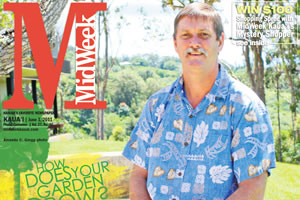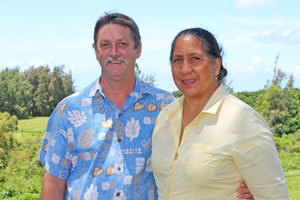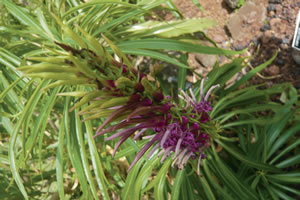How does your garden grow?

Chipper Wichman, director of the National Tropical Botanical Garden, wants to increase opportunities for public education and scientific research.
The National Tropical Botanical Garden grows very well, and now its director is looking at ways to open it to more education and research
Chipper Wichman thinks big. The chief executive officer and director for the National Tropical Botanical Garden has been servicing science and botany for the past 35 years, and is now thinking globally in terms of highlighting our Garden Island.
Wichman, who built a new research headquarters and expanded its role in conservation of native and rare plants, not only is active in the community, but now wants to expand NTBG further. He plans to augment the role of the four spectacular gardens and five preserves located throughout the state to become part of a world center for the study of tropical botany.
“Most people on this island, if you talk to them about NTBG, they probably think we’re just Allerton Garden – but in reality we are so much more than that,” he says. “My hope is to be able to expose people – both our residents and our visitors – to a little more depth of what we do.”

Chipper Wichman with the first of six volumes from an old Dutch herbal book that took eight years to translate. Amanda C. Gregg photo
Wichman says NTBG isn’t just beautiful gardens with fountains and statues, but is actually a family of five gardens and five preserves on Kaua’i, Maui and the Big Island that make up the best “outdoor classroom” in the world.
“The McBryde Garden is our flagship garden,” he says, “and while we have been developing it since 1970, we have been doing so primarily to fulfill our mission of conservation and scientific research and not as a garden designed to educate our visitors.”
Wichman credits much of his success with the nonprofit to his wife Hau’oli, who is his full-time executive assistant and shares an office with him. Wichman says she keeps “the speeding train on the tracks.” That’s key, as he is a virtual whirlwind of ideas and activity.
“It has been a real blessing for me to get to undertake this incredible journey with her by my side,” he says.
The couple has two children, son Imipono and daughter Mikioi, who both graduated last month from the University of Hawaii. For fun, Wichman enjoys hiking, diving and working in his yard (makes sense). Though he grew up on Oahu, he spent summers here on Kaua’i with his grandmother, and moved here full time in 1976 when he started working at NTBG.

Chipper, Imipono, Mikioi and Hau‘oli Wichman on graduation day last month
Wichman says while science and conservation will continue to be NTBG’s primary focus in developing the garden’s “living collections,” the goal is to pay more attention to how they are displayed and subsequently interpreting them to the public.
“Education has always been a core part of our mission, and we conduct educational programs for everyone from preschool children to medical (doctors) to environmental journalists,” he says. “Despite this, we have a lot to learn in terms of marketing and PR, and making McBryde Garden a place that locals and visitors want to come and experience.”
Wichman hopes it becomes a “must see” location on everyone’s list. (And he gave us a shout out, too). “We were quite pleased this year when we were voted ‘Best of the Best’ in the garden category of the recent MidWeek readers’ poll,” he says. “While the award indicates we are on the right track, we are now in a planning process that has the goal of making the McBryde Garden a world-class educational destination for visitors and our community.”

A sample from the Allerton ‘cutting garden’. NTBG photo
Already one of the most beautiful sites in the world with a spectacular waterfall, beautiful stream, stunning topography and thousands of tropical plants, Wichman admits it’s never had a cohesive infrastructure plan with paths, trails, restrooms, as well as engaging interpretation to make the experience meaningful to the average visitor.
“Botanists love it – all our plants have accession tags documenting their provenance and origin, and are all part of our database that includes GPS coordinates and generates GIS maps,” he says. “From a research standpoint, we have all the bells and whistles.”
But from a visitor’s standpoint, it needs a bit more.
Wichman hopes to transform the garden into a place where locals and visitors can become educated on issues affecting the Garden Island and the rest of the world.
“We’re looking at taking this garden and using it to educate people about things like the extinction crisis here in Hawaii, the global biodiversity crisis, the challenges that global climate change will bring to Kaua’i and the global effort to conserve biodiversity and the environment,” he says. “There’s really no better way to educate people than through a garden like this. It’s an emotional experience, not just an intellectual experience – it is a truly three-dimensional sensory experience.”

Ancient taro terraces at Limahuli with Mount Makana as a backdrop
While improving the visitor experience at McBryde Garden is at the top of his list, it is by far not the only “big idea” Wichman is working on.
Proudly holding up yet another project – a thick tome titled The Ambonese Herbal that represents 50 years of ethnobotanical research by Georgius Rumphius, a naturalist who lived on a remote island in the Dutch East Indies – Wichman explains the original 8,000-page manuscript was written in archaic Dutch. In 2000, NTBG, which has a complete set of the rare books in its research library, commissioned Eric Montague Beekman, a professor of German and Dutch literature, language and culture, to translate it (it took eight years and another three to prepare the 6,000-page manuscript for printing).
The complete set of all six volumes will be released in July – and already has resulted in new medicines being developed by researchers at the Mayo Clinic in Rochester, N.Y.
“Pretty exciting stuff that came right out of our library here in Kalaheo,” Wichman says.

Chipper and Hau‘oli Wichman work side by side at NTBG. Amanda C. Gregg photo
That’s not the only way NTBG is growing and affecting the world and its scholars. Last month, while at The Kampong, the NTBG’s garden located in south Florida, Wichman met with the president of Florida International University and potential funders who support higher education at universities across the country to develop plans to launch a multi-million-dollar campaign to create a world center for the study of tropical botany. Wichman is working to partner with the university to have Kaua’i as the location for field study. The idea addresses the issue of how expensive it is for students to travel and live here for an extended period of time, but would still bring students for abbreviated periods.
“We have found that hosting some of our national education programs on Kaua’i has been challenging in terms of both cost and travel time (for the students),” Wichman says. “Over the years we have found that our property in Florida is a lot more affordable and accessible for people – a plane ticket from anywhere in the U.S. is a fraction of the cost of a ticket to Kaua’i.”

This endangered lobelia is native to Kaua‘i. NTBG photos
With that in mind, the idea of partnering with FIU seemed to be the answer.
“This partnership will create what I believe will be some amazing synergy,” he says. “FIU has a robust biology department and a strong interest in ethno-botany. Partnering with our organization – which is the only botanical garden chartered by the U.S. Congress and the only truly tropical botanical garden in the country – gives us an ideal opportunity to create a world center that will encompass all that south Florida has to offer as using NTBG as a stepping off point for research throughout the Pacific.”
NTBG is already partnering with the University of Hawaii, so working with FIU seems a solid step in growth. “Kaua’i is an ideal field school site where students from the center can apply what they are leaning in the classroom in Florida by being immersed in a tropical environment rich with unique biodiversity and a vibrant indigenous culture,” he says. “Combine that with the NTBG research network throughout the Pacific, and you have an ideal partnership that will benefit the Garden Island and the University of Hawaii and generate new leaders who will be prepared to take on the global challenges we face in the years ahead.”



